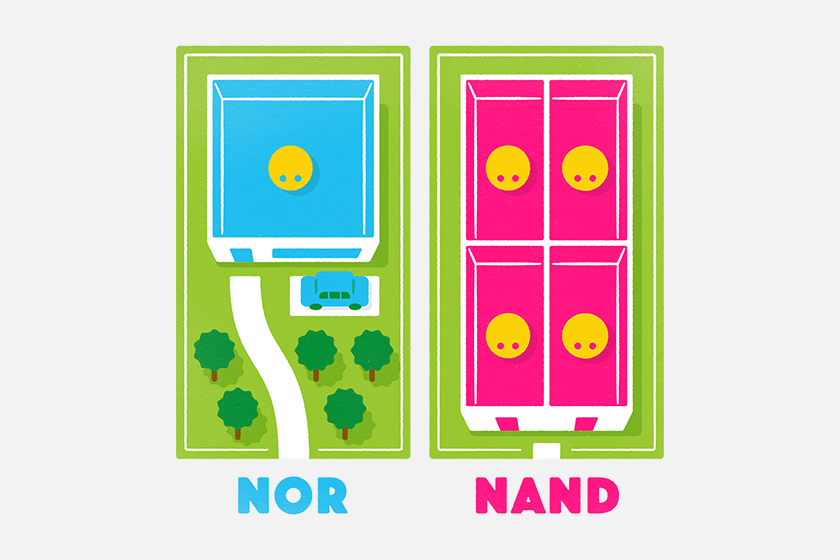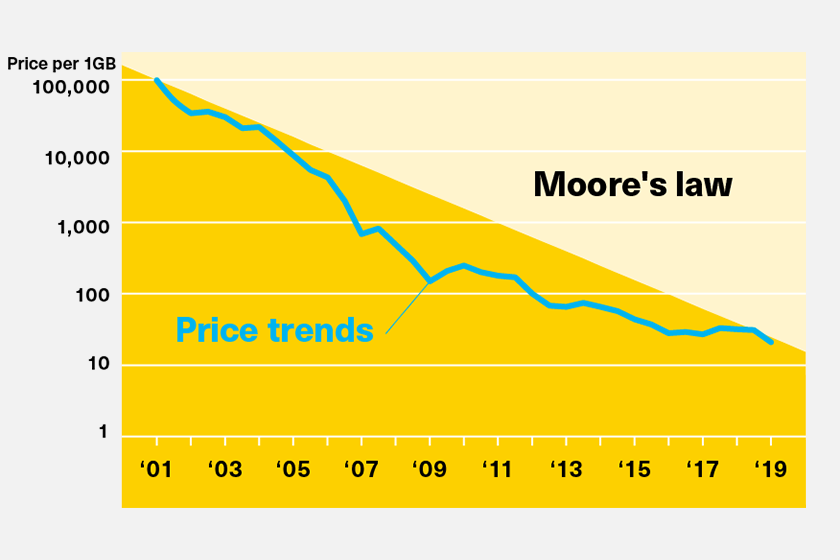Please select your location and preferred language where available.
Where is Memory Technology From, and Where is it Headed


- The History Of Our Memory -
October 1, 2019
In 1987, well before the spread of the Internet in Japan, Dr. Fujio Masuoka (formerly with Toshiba, now an honorary professor at Tohoku University) created the world’s first NAND flash memory. Taking advantage of characteristics such as its compact size, reasonable price, and rapid reading / writing capability, the technology is now being used in PCs, smartphones, digital cameras, and many other devices. In fact, it serves as a foundation of the information society. In the following discussion with Kota Yamaji of KIOXIA, we follow this technology trajectory and value NAND flash memory has brought to society. The interview is conducted by journalist Katsura Hattori, covering a leading technology for many years.

NAND Flash Memory, Born on the Eve of the Spread of the Internet
──First, let’s do a simple review of flash memory, first created by KIOXIA (formerly Toshiba).
Yamaji: Flash memory is an “extremely small storage device utilizing a semiconductor,” and is incorporated into familiar items such as smartphones, tablet computers, video cameras, and game machines. USB memory, which we use regularly to transfer data, also uses flash memory. Toshiba created the world’s first NOR flash memory in 1984, and in 1987, it invented NAND flash memory, which is widely used still today.
──Not only had the Internet not yet spread in 1984; but computers were also not yet widely used. Computers, costing as much as a small car, had at last become usable for word processing and spreadsheet calculations. However, they couldn’t handle video and audio as the data was too large. Released that year, the memory of the Apple Macintosh was 128KB, and around that time Bill Gates said, “If a computer has 640KB of memory, it’s enough.” Flash memory is technology that was born at the dawn of the IT age.
Yamaji: Yes, it was invented by former Toshiba researcher Dr. Fujio Masuoka. At the time, tape and disks were the mainstream as storage devices that did not require a power source (non-volatile memory). However, storage device using magnetism had drawbacks such as long read / write times and bulky sizes.
──Was flash memory developed through efforts to overcome these weaknesses?
Yamaji: Yes, that’s exactly right. Dr. Masuoka was convinced that “Using flash memory, people will be able to carry dozens of songs and listen to them while running.” Around that time, portable cassette players had spread, and future digital portable music players expected to come. However, in terms of design, it was difficult to create a large-capacity NOR flash memory. The issue was how to enlarge storage capacity while retaining a compact size.
The conclusion we finally arrived at was that NAND flash memory had a smaller circuit scale and was more amenable to storage capacity expansion than NOR flash memory. Operating principles were announced in 1987, and Toshiba was the first to commercialize. Today, this is the type of flash memory that is most prevalent.
──How does flash memory work?
Yamaji: Flash memory stores information by holding electrons in parts called memory cells, which exist in innumerable quantities on the integrated circuit chip. It stores information based on the presence or absence of electrons through either holding or discharging.
Think of it as the chip being the land and the cell being the home. It’s like increasing the number of homes on a piece of land of a fixed size—the more memory cells there are, the more information that can be stored.
NAND flash memory is a breakthrough invention that made enlarging storage capacity possible without increasing chip size, simply based on ingenuity. Subsequent research and development efforts were focused on the downsizing of cells to enable the storage of more information. And the enlargement of storage capacity proceeded at a pace surpassing that outlined in Moore’s Law.
*Moore’s Law: Put forward by Gordon Moore, one of the founders of Intel, in 1965. And an updated principle states: “The number of transistors incorporated in a chip will approximately double every 18 months.”
Applying an updated Moore’s Law to the flash memory semiconductors, capacity based on chip size doubles every 18 months. This means, a fourfold increase in three years, and about 100 times in 10 years. Stated another way, the price in terms of capacity decreases to about 1/100 over 10 years.
The density of the NAND increased at a pace surpassing Moore’s Law through technology such as grating, in addition to miniaturization. A basic NAND flash memory stores 1 bit based on the presence or absence of electrons in a single cell, but by subdividing the electronic state within a cell, grating technology enables the storage of 2 bits or more. I’ll spare you a detailed explanation for now, but at the end of the day it means that more than twice the amount of information can be stored in the same space.

The essence of flash memory is in the Digitalization of Visual Media
──When was it that flash memory began to become prevalent?
Yamaji: Since 2000. In 1995, Toshiba developed “smart media,” a card-type flash memory. It was about four centimeters square, less than one millimeter thick, and it weighed two grams. It was used in products like digital cameras, which at the time had begun to spread.
Then, in 1999, the SD Memory Card, which is widely used even today, appeared. Around that time, there were many types of memory cards, but gradually memory adopting the SD Memory Card standard grew, and today almost all digital cameras produced by major manufacturers are compatible with the SD Memory Card.
──Lightweight, compact, and energy saving. Can we say that flash memory, which has these characteristics, is essential to digital cameras, which were designed to be portable?
Yamaji: Yes, we could say that. Once digital camera performance increased and users were able to capture higher-definition images and videos, data capacity needs grew. With this, the demand for large-capacity flash memory also grew rapidly. The first SD Memory Card capacity was around 16MB, but today 128GB and 256GB products are the mainstream. Naturally that trend also applies to mobile phones and smartphones. As device performance increased, the volume of data they could handle also grew, which drove an increase in flash memory capacity.
Hard disk drives, or HDDs, which employ a magnetic disk, are widely used today as equipment for large-capacity storage. Nevertheless, flash memory is overwhelmingly superior in terms of reading / writing speeds and space efficiency, so flash memory is needed for mobile devices. However, looking at price from the perspective of recording capacity, HDDs are less expensive, so for personal computers and data centers which require large storage capacity, flash memory has not completely replaced HDDs. It’s no exaggeration to say that, in this field, HDD is flash memory’s single largest competitor.

Did the Reduction in the Price of Memory Revolutionize Mobile Devices?
──That reminds me—the first iPods developed by Apple employed HDD. After that, I remember that the iPod Nano, which used flash memory, made its appearance, and that storage capacity shrunk. However, it’s not so easy to defeat HDD simply based on price.
Yamaji: That has recently begun to change.
──What’s the reason for that?
Yamaji: There was a significant technological innovation. Limits to increases in capacity through cell miniaturization began to be seen around the beginning of the 2010s. The continuous reduction of cell size led to a decrease in the number of electrons that would store in the cell, making errors more likely. At this point, 3D technology emerged.
Instead of memory cell miniaturization, cells were stacked vertically, enabling an increase in the number of cells on a chip and enlarged capacity. It’s like a single-story house becoming a high-rise apartment building. Toshiba was the first to present this at an academic conference in 2007, and today we are mass producing a 3D flash memory with 96 layers.
The enlargement of flash memory capacity continues even today through such technological innovation. Looking at smartphones—which just about everyone has these days— flash memory innovation was essential to their growth. It may sound like self-flattery, but in addition to the characteristics flash memory has always had—light weight, compact, energy efficiency—you could say we played a crucial role in the innovations such as miniaturization and 3D technology that made enlarged capacity possible.

What is the New Role for Memory in the Era of Continuously Increasing Data?
──Having listened to you, I’ve been reminded of the high versatility of flash memory. It is technology that has indeed supported the mobilization of IT.
Yamaji: It makes me happy to hear you say that. It’s true that without flash memory having been invented, and all the technological innovation that followed, global mobilization would now have developed so rapidly.
These days, mobile personal computers equipped with solid state drives, or SSDs, employing flash memory in place of HDDs have increased. Also, the price has closed in on that of the HDD, so use by data centers, which store big data, has grown.
──5G lines will soon be installed, so we will soon enter an era in which the handling of large volumes of data will be a given. At the same time, looking back at the history of information technology, we have repeatedly seen ultra-high technology that formerly could only be used by nations and corporations become increasingly common.
GPS, for instance, which was developed by the US for military was a state secret, but today everyone uses it. Given this, the era in which any of us can use big data will very likely come. It will probably become possible to forecast the weather around our homes, or forecast and analyze our physical condition and changes in our emotional state.
Yamaji: That would really be interesting. In any case, the more technology advances, the more important data will become. These days, against the backdrop of trends including IoT, AI and autonomous driving technology, there is new demand emerging for flash memory, which stores and processes large amounts of data rapidly.
As I’ve said, the history of flash memory shows that, even across eras, we have continued to drive this technology forward while meeting new demand. By evolving flash memory and transforming it from simply recording to a new “memory,” we hope to drive these changes in society.

Katsura Hattori
Born in Tokyo in 1951, Hattori graduated from the electronic engineering program at Waseda University’s Faculty of Science and Engineering in 1978 and joined Asahi Shimbun. He studied abroad as a researcher from 1987 at MIT’s Media Lab, where he conducted investigations into the US media industry. After returning to Japan, Hattori was involved in the production of ASAHI Pasocon and Doors, IT industry journals issued by Asahi Shimbun. In 2016, he retired from Asahi Shimbun and has continued to work independently. Hattori has penned numerous books, including “Jinko Genjikkan no Sekai,” “Jinko Seimei no Sekai,” “Media no Yogensha,” and “McLuhan wa Message.”
Kota Yamaji
Kioxia Corporation
Born in Kanagawa Prefecture in 1972, Yamaji joined Toshiba as a systems engineer in 1997. Since 2013, he has been in charge of public relations for the semiconductor division. He then took over public relations upon the formation of Toshiba Memory (Current KIOXIA) in 2017.
Author: Yoshiaki Aizawa
Illustration: Takuro Takagi
The content and profile are current as of the time of the interview (October 2019).


